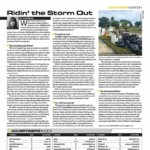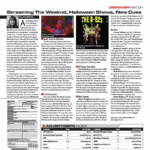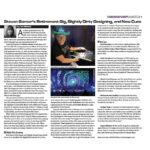Sydney-based Mandylights lighting designers Richard Neville and Alex Grierson were part of the international creative team that designed Dubai’s 2013 New Year’s Eve celebrations. And it was a tall order — instead of focusing on, say, the 141-foot descent of an elaborate ball in Times Square, the 25-minute show took place in front of, and included, the Burj Khalifa skyscraper — officially the world’s tallest building at 2,722 feet high. The pair illuminated the Burj, lake and surrounding area with 15 individual performer stages and a 689-foot-long (210 meter) seamless projection screen.
 Neville and Grierson worked on the project for six months with an international creative team that had just four dress rehearsals to nail down the choreographed interplay of 350 intelligent lights, flame projectors, 79 performers and thousands of programmed water fountains before the big show.
Neville and Grierson worked on the project for six months with an international creative team that had just four dress rehearsals to nail down the choreographed interplay of 350 intelligent lights, flame projectors, 79 performers and thousands of programmed water fountains before the big show.
The show’s premise was based on the diverse natural and cultural elements of the world and how they all come together, Neville says. The energy of the elements travel across the world to finally reach their destination at Dubai, the place where people come together in celebration of friendship and cultural understanding. As the energy arrives, it erupts in a show of water, fire, light and sound.
 The show, accompanied by the Prague Philharmonic Orchestra, was first performed on New Year’s Eve, just before the midnight fireworks, for a site-wide audience of 1.7 million people. Many of the show’s elements then appeared twice nightly throughout January.
The show, accompanied by the Prague Philharmonic Orchestra, was first performed on New Year’s Eve, just before the midnight fireworks, for a site-wide audience of 1.7 million people. Many of the show’s elements then appeared twice nightly throughout January.
We spoke with Neville, who served as LD/programmer on the project, about its massive scale.
» PLSN: What were the challenges in lighting the world’s tallest building?
Richard Neville: Working with a site that had equipment spread out over almost half a square kilometer was extremely difficult—there was no one vantage point where you could actually see every lighting fixture or what the lights were projecting onto, so it took a lot of planning, visualization and long walks to ensure that programming was localized for each area. Many of the on-water stages were located in little nooks and crannies in the lake, while others were out in water with no obstructions around them, so a searchlight effect that might look great on the main part of the lake might be blasting a few thousand watts of light into a hotel room around the corner.
The creative constantly developed as we programmed, and a huge number of our cues took their placements and timing from the huge video component of the show. Almost on a daily basis, we’d be reviewing updated video creative and then spending time tweaking our cues—or in some cases re-writing entire sequences—so that the lighting and video could appear to operate as seamlessly as possible.
» PLSN: What were some of the biggest challenges?
RN: With equipment spread over such a huge site, maintenance was a challenge. A single fixture swap in the middle of the lake might take three hours by the time a crew member had identified the problem, taken a replacement out on an electric boat, navigated their way through the lake’s maze of fountains, pyro and other rigging, built the scaffolding to access the light and then performed the actual swap. We only had four nights of programming with the actual rig, so maintenance could take entire groups of fixtures out for a night at a time and make life all the more difficult.
» PLSN: Any major time challenges?
RN: We first got wind of the project back in May 2012, and we became part of the team bidding to produce the show. On my way from Sydney to Shanghai to light a new Chinese production of Cats in July, I took an ever-so-slight detour through Dubai for a few days (this was before we’d even won the project) just to get my head around the site in the event that we did win the bid. We then started work in late July, and Alex and I spent a full month on site in December in the pre-viz suite and around the bump-in site, which took over three weeks.
» PLSN: Any weather challenges?
RN: Everyone told us “it never rains in Dubai in December,” so initially, there was little wet weather protection planned. When we landed, it rained solidly for three days and brought the city to a standstill, so there were a few crisis meetings. We agreed on rain hats for all the moving lights. A week or so down the track, we also realized that the thousands of fountains in the Dubai Lake create a huge amount of moisture in the area, so the rain covers quickly evolved into complete acrylic housings for every fixture on the lake.
» PLSN: How would you describe your design and programming approach?
RN: I love to use strong lines of light in my designs, so I approached this show in the same way. I put long lines of ACL fixtures in across the tops of the various screens so we could suggestively extend the color and content of the video out from the screen surfaces and then made sure we programmed with a lot of detail to keep the lighting true to the video. We ended up with a huge fixture count and site, but we spent time with every individual fixture, making sure they all fit into the show as a whole.
Probably the biggest change of thought comes in programming; my associate, Alex Grierson, and I split the rig up into parts and programmed separate cue lists so that we could each pay more attention to specific parts of the rig. In some sequences, I’d have a couple of cues while Alex would be madly programming moving lights to follow each step of performers on the lake stages, while at other times I was frantically programming reactive cues to the 210-meter-long (689-foot-long) screen while Alex would have time for a coffee.
» Quick Cues…
The Nutty Irishman, a pub/restaurant that has also been serving up live music, celebrated 10 years by making its locations in Bayshore and Farmingdale, NY a little “greener.” The original LD, Blake Elkin, was brought back for a thorough retrofit, replacing the dance floor and architectural lighting systems with all-LED products. “Maintenance is a thing of the past in smaller nightclubs, and LED systems perfectly fit the bill and are an easy sell to nightclub owners,” he says. Elkin continues to serve as the in-house lighting designer/director and programmer for The Paramount, a venue for national touring acts, also on NY’s Long Island (in this case, Huntington, NY)…
LD Ethan Weber has designed Green Day’s arena tour, which kicked off March 28 in North America. The group unofficially launched their run of dates a little earlier with a special gig at SXSW in Austin, TX…
LD/programmer Stan Green is designing Tom Petty’s summer run. He describes it as “a short little tour with a week in a theatre in L.A., a week at the Beacon in New York, a few arenas, sheds and festivals…”
LD Jonathan Goldstein is out with Alicia Keys’ ‘Set the World on Fire’ tour…
LD Mike Duncan heads out with Meat Loaf for a U.K./Europe run of arenas starting in April. He spent a few days in Austin, TX for rehearsals with the artist…
LD Steve Fallon was the LD and media designer for the Country Radio Seminar shows in Nashville…
Share news of your upcoming and current gigs with Debi Moen at dmoen@plsn.com.


